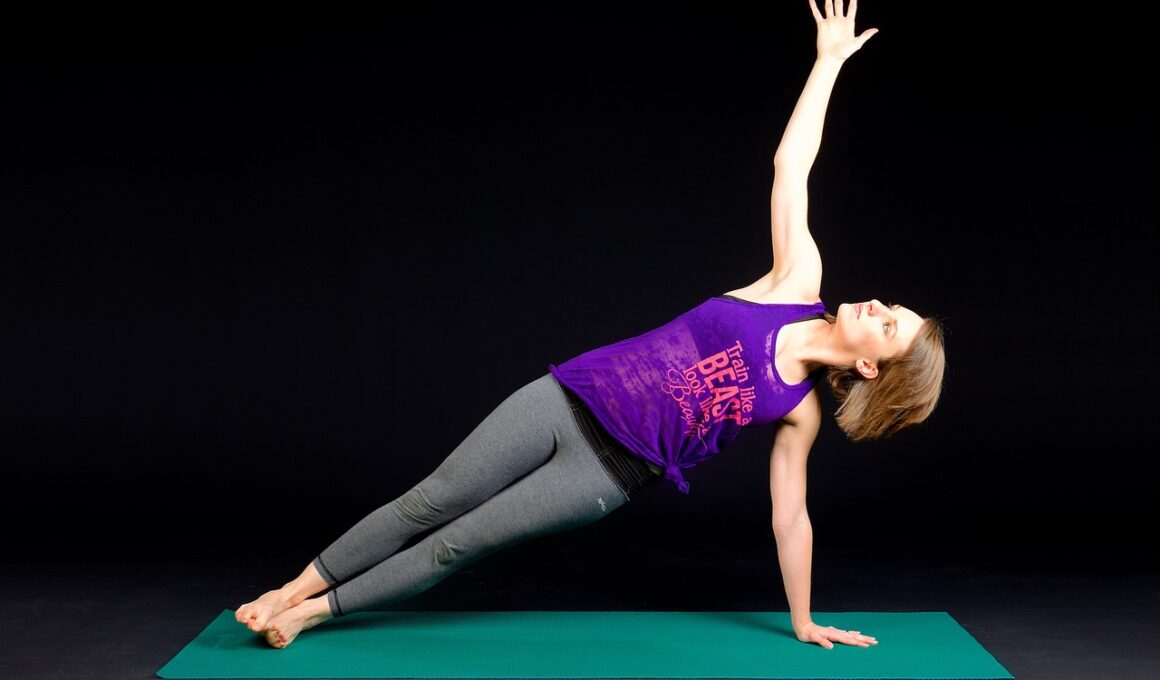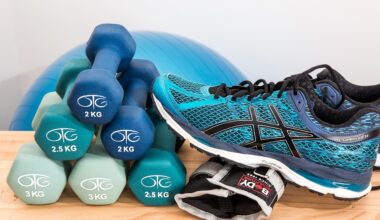Improving Posture with Week 5 Core Stability Exercises
Core stability exercises are essential for enhancing posture, providing a strong foundation for overall movement and fitness. In Week 5 of our workout plans, we will focus on exercises that target the abdominal muscles, lower back, and pelvic area. These areas play a crucial role in maintaining proper alignment and posture throughout daily activities, whether sitting, standing, or even walking. To achieve this, incorporate exercises such as planks, bridge lifts, and torso rotations into your routine. These movements engage multiple muscle groups simultaneously, promoting balance and stability. Improving your core strength offers numerous benefits, including reduced back pain and decreased risk of injuries when lifting heavier weights or engaging in other activities. A strong core supports the spine, allowing you to carry out exercises efficiently and effectively. Additionally, practicing good posture while performing core exercises ensures maximum benefits. As you progress through Week 5, continue to focus on form and controlled movements. Quality over quantity is critical, as improper technique can lead to injuries. Building a solid foundation during this week will set you up for success in future weeks and improve your overall fitness journey.
Incorporating balance exercises into your core stability routine is vital for enhancing overall strength and coordination. Week 5’s workout plan emphasizes activities that challenge your balance while simultaneously engaging your core muscles. Balance exercises, such as single-leg stands and stability ball workouts, significantly improve proprioception or the body’s ability to sense its position in space. This skill is particularly important for maintaining proper posture and stability in daily activities and sports-related movements. Performing these exercises helps facilitate better body awareness, ultimately leading to improved posture on and off the mat. To incorporate these elements effectively, merge stability challenges with traditional core exercises to engage your entire core unit. Work on integrating movements such as side lunges or squat variations into your workouts. Always remember to maintain an emphasis on proper form and controlled movements to reduce injury risk. As your stability improves, aim to progress to more challenging variations of each exercise, enhancing your overall core strength and coordination. By the end of Week 5, you’ll notice a marked improvement in your posture and balance, fostering a solid foundation for future fitness endeavors.
Focusing on Flexibility in Core Stability
Alongside strength and balance, flexibility plays an integral role in improving core stability, posture, and overall health. During Week 5, incorporate stretching into your routine to enhance muscle elasticity and promote recovery. Key stretches to consider include the cat-cow stretch, seated forward bend, and hip flexor stretches. These movements help alleviate tightness in the muscles surrounding your core, allowing for greater mobility and improved functional performance. As your flexibility increases, you’ll find it easier to maintain good posture throughout daily activities, reducing the strain on your spine and surrounding muscles. Pair these stretches with your strength training for a well-rounded approach. Focus on holding each stretch for 15-30 seconds, allowing your muscles to relax and lengthen. This can lead to reduced soreness and quicker recovery times after intense workouts. Additionally, incorporating these flexibility exercises into your warm-up routine can help optimize performance and reduce injury risks. As you progress through Week 5, make it a point to reflect on how improved flexibility can influence your overall workout experience, not just in terms of core stability, but across all aspects of fitness.
Implementing a variety of exercises throughout Week 5 will help maintain your motivation while ensuring well-rounded core stability training. Start by creating a weekly schedule that incorporates core exercises, balance training, and flexibility work. This balanced program will keep you engaged while addressing various aspects of core health. Additionally, setting specific fitness goals, such as holding a plank for a longer duration or improving your flexibility, can provide you with a clear target to work towards each week. Monitoring your progress not only reinforces your achievements but also helps identify areas that may require extra attention in your training. Consider using a workout journal to log the details of your exercises, including sets, reps, and any modifications made. This will contribute to your overall accountability and commitment to improved fitness. Social support can also enhance your workout experience, so invite friends or family to join your core stability sessions. Sharing achievements and struggles with workout partners can boost motivation and create a sense of camaraderie, making it easier to stay consistent in your regimen. Embrace this journey through Week 5 and celebrate your progress in enhancing your overall fitness.
The Importance of Core Stability
Core stability is often underestimated, yet it plays a vital role in supporting nearly every movement your body performs. A well-conditioned core not only enhances performance in sports or physical activities but also benefits daily life. Improving core stability can lead to better postural alignment, which, in turn, minimizes the risk of developing chronic pain, particularly in the back and neck areas. By focusing on core exercises like those included in Week 5, individuals can develop the necessary strength to withstand the demands of everyday activities. As your core muscles become more robust, you will experience better athletic performance, including improved agility, balance, and power. Additionally, a strong core helps to stabilize joints throughout the body and enhances overall coordination. This foundation is crucial if you wish to progress to more advanced training methods in the future. Thus, prioritizing core stability is the first step toward gaining better control over your body, ultimately fostering sustainable improvement in performance across various fitness levels. Invest time in this area, and you’ll recognize the significant benefits that a strong core provides in your ongoing fitness journey.
As you engage with the core stability exercises throughout Week 5, remember that consistency is key to achieving the desired results. Incorporate these movements into your existing workout regimen, striving to solidify your routine by exercising at least three times per week. Regular practice will not only enhance muscle conditioning but also reinforce neural pathways that support proper posture. As you incorporate new movements, make adjustments to accommodate your fitness level and individual needs. Use modifications where necessary, and gradually increase the challenge once you become comfortable with each exercise. It is essential to listen to your body and allow for adequate recovery time, as fatigue can hinder your progress and increase the risk of injury. Alongside your core workouts, maintaining a healthy diet rich in nutrients is crucial. Proper nutrition provides the necessary fuel to promote muscle recovery and growth. Keep hydration in mind, ensuring you drink plenty of water during and after workouts. In conclusion, a comprehensive approach to core stability, including consistent practice, nutrition, and recovery, will pave the way for the enduring postural improvements you seek.
Conclusion: Bringing It All Together
With the completion of Week 5, you will likely notice significant changes in your posture and overall core stability. This week’s exercises will serve as a foundation for future training, so it’s essential to continue building upon the progress you’ve made. Reflect on your experiences, acknowledging the improvements you’ve accomplished, and identifying areas where you feel you can continue to grow. Remember that patience is vital; the journey to optimal posture and core strength takes time and consistency. Engaging regularly with the exercises from this week, as well as incorporating balance and flexibility techniques previously covered, will foster durable improvements in both posture and core strength. As you advance to another week, consider setting new goals based on your progress, and evaluate how you can further challenge yourself in your fitness journey. Staying motivated means celebrating each milestone, no matter how small, and ensuring you remain invested in your long-term success. As you embrace these changes, always keep in mind the long-term benefits of core stability, not just for fitness but for everyday life.


